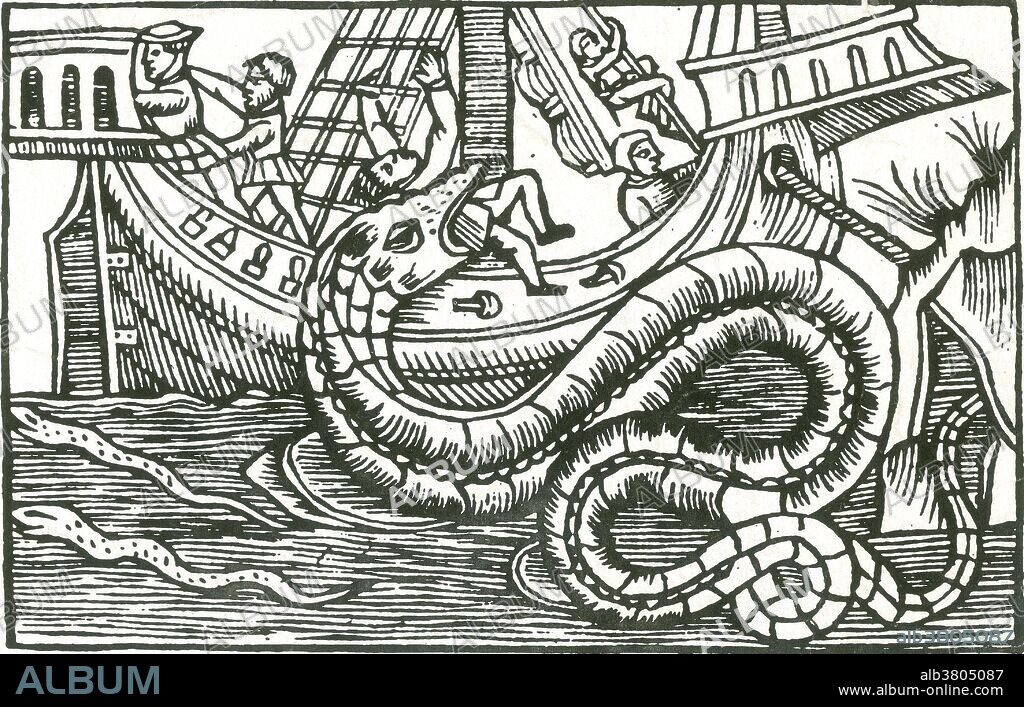alb3805087
Kraken Attacking Ship, 1555

|
Añadir a otro lightbox |
|
Añadir a otro lightbox |



¿Ya tienes cuenta? Iniciar sesión
¿No tienes cuenta? Regístrate
Compra esta imagen.
Selecciona el uso:

Título:
Kraken Attacking Ship, 1555
Descripción:
Traducción automática: En la obra de Olaus Magnus, Historia de los pueblos del norte, de 1555, describe una serpiente noruega tan audaz que salía de su cueva submarina en las brillantes noches de verano para darse un festín con terneros, corderos y cerdos. Se decía que esta bestia medía 200 pies de largo y 20 pies de ancho y se creía que vivía en las afueras de Bergen. Lo más inquietante, sin embargo, fueron los ojos rojo fuego de esta bestia y su inclinación por comerse a la gente. La cruel criatura atacaba a los barcos y se deleitaba con su gente mientras se elevaba desde el agua hacia el cielo. También identificado como Kraken. La leyenda puede haberse originado a partir de avistamientos de calamares gigantes que se estima que crecen entre 40 y 50 pies de largo, incluidos los tentáculos. El gran tamaño y la apariencia temible atribuida al kraken lo han convertido en un monstruo común que habita en el océano en varias obras de ficción.
In Olaus Magnus' 1555 work History of the Northern Peoples, he describes a Norwegian serpent so bold that it would come out from its underwater cave on bright summer nights to feast on calves, lambs and pigs. This beast was said to be 200 feet long and 20 feet wide and was believed to live outside Bergen. Most disturbing, however, was this beast's flame-red eyes and penchant for eating people. The vicious creature would attack ships and feast on its people as it lifted itself straight up from the water toward the sky. Also identified as a Kraken. The legend may have originated from sightings of giant squid that are estimated to grow to 40-50 feet in length, including the tentacles. The sheer size and fearsome appearance attributed to the kraken have made it a common ocean-dwelling monster in various fictional works.
Crédito:
Album / Science Source / New York Public Library
Autorizaciones:
Tamaño imagen:
4372 x 2793 px | 34.9 MB
Tamaño impresión:
37.0 x 23.6 cm | 14.6 x 9.3 in (300 dpi)
Palabras clave:
1555 • ADJUNTANDO • ANIMAL • ARTE • BARCO • BLANCO Y NEGRO • BOTE (BARCO) • CREATURE • CRIATURA • CUENTO POPULAR • DIBUJO • FOLKLORE • GRABADO EN MADERA • HISTORIA • HISTORICO • ILUSTRACION • IMAGINARIO • LEGENDARIO • LUCHA • LUCHANDO • MARINA • MARINEROS • MÍTICO • MITO • MITOLOGICA • MITOLÓGICO • MONSTER • MONSTRUO MARINO • MONSTRUO • OBRA DE ARTE • PLANCHA DE MADERA • S. XVI • SIGLO XVI • XILOGRAFIA
 Pinterest
Pinterest Twitter
Twitter Facebook
Facebook Copiar enlace
Copiar enlace Email
Email
